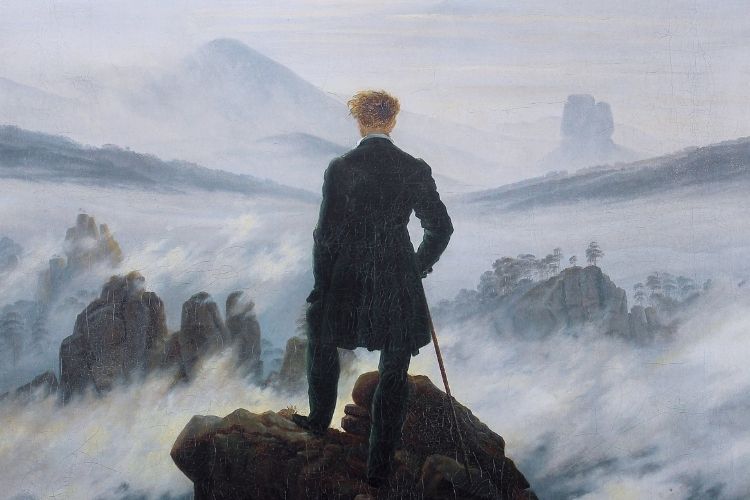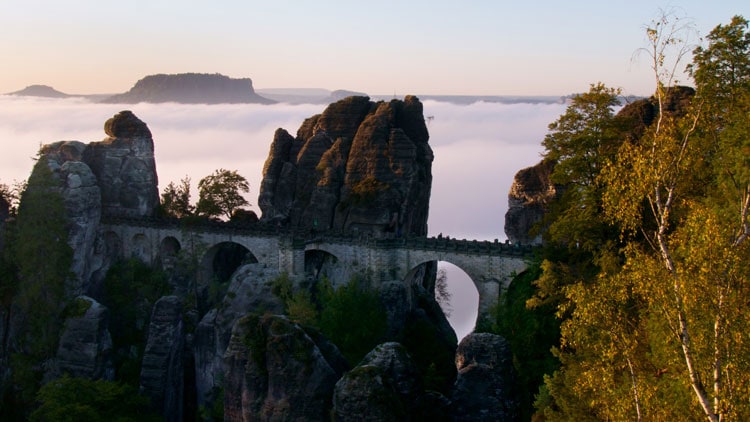
Go World Travel is reader-supported and may earn a commission from purchases made through links in this piece.
Imagine a magical place that transports you back to the era of German Romanticism. A place of humid, foggy forests full of juicy green ferns, mosses and lichens combined with rocky peaks and bizarre stone formations.
This unique place is equally perfect for rock climbing, cycling and hiking as it is for a romantic weekend with art and nature. Just grab your backpack and set out on the trail of Romanticism artists through Saxon Switzerland.

Where is Saxon Switzerland?
There is a region in Europe called Saxon Switzerland, where you can plunge into another world and time. Contrary to the name, Saxon Switzerland is actually in East Germany on the German – Czech – Polish border. It’s about 30 kilometers away from Dresden, the capital of Saxony Land, in the Elbe River valley.
It owes its name to the Romantic era Swiss artist, Adrian Zingg and his fellow artist friend Antonn Graff. Legend has it that during his stay in Dresden, Zinggstarted to call the region Saxony Switzerland because it reminded him of his beloved homeland.

Saxon Switzerland’s Natural Beauty
Here, in Saxon Switzerland, you can admire the rocky peaks of the Polabian Mountains as well as the beautiful and peaceful meandering river Elbe.
This river is the source of dense mists that spread over the whole region. Mists that create stunning sunrises, especially in the early autumn.
The formation of the unique Elbe Sandstone Mountains dates back to the Cretaceous period. Thousands of years of exposure to wind and water have eroded into bizarre and beautiful shredded rock formations and peaks.
In addition, Saxon Switzerland is a great place to observe the Inversion phenomenon in the mountains. During this phenomenon, clouds and mists sit below the mountain peaks creating a mystical and magical sight.
Furthermore, the hills are surrounded by the foggy, lush-green forests mentioned above. All these elements combine to create a romantic vision of fog enveloped trees with just the bald mountain peaks protruding above the thick white cloud.

Saxon Switzerland National Park
The National Park of Saxon Switzerland is free to enter. In the park is a trail stretching over 93 kilometers between the German city of Pirna and the Czech border.
In addition, there are 400 square kilometers of walking trails of various lengths and difficulty levels. Plus, over 700 rocky peaks, numerous bicycle routes and rock-climbing spots.
Land authorities encourage people not to travel around the park by car. To aid with this there is a well-developed public transport network in the region. There is a railway along the Elbe River and on the winding, mountain roads there are many buses transporting tourists between the routes.

There is also a historic tram line within the park. The tram Kirnitzschtalbahn called “yellow car” started its run in 1898. Nowadays the machine runs partly on solar energy (40%) and is also a historical attraction. A return ticket costs 9 euros for an adult.
Furthermore, you can use ferries. The level of commitment to keeping the area as natural as possible is impressive. In keeping with this, there is only one bridge within the park which naturally reduces car traffic and pollution.
Therefore, the fastest way to get to the other side of the river is by pedestrian ferries, of which there are many. Crossing from one side to the other costs around 1 euro.

Routes of Saxon Switzerland
There are dozens of routes around Saxon Switzerland allowing for a customized itinerary to suit your needs. The routes vary in length and difficulty levels with everything from an easy walk to an adventure including rock climbing or trekking through the dense, muddy forest.
In addition, there are circle trails that allow you to start and end at the same point that you left your car or have accommodation.
What deserves a special mention is the 116 km route called “Malerweg”. It is dedicated to the painters of Romanticism who visited the region in great numbers in search of inspiration.
The trail starts in the town of Pirnaand and runs through the most interesting and picturesque points of Saxon Switzerland. The route is marked with the letter “M” inscribed in a white square. If you come across such a sign on the route you can be sure that you are walking a part of the trail.

Malerweg Route
Malerweg has been divided into 8 stages of varying lengths. with an overnight stop at the end of each stage. It is possible to walk the trail from the beginning to the end within 8 days.
For those who value convenience, local tourist offices offer the option of organizing a trip. These include booking accommodation and transporting luggage allowing for an easier, lighter walk between stops at your hotel.
The most exciting part of the Malerweg trail, aside from the breathtaking views, is the fact that it follows the steps of artists of the Romantic era.
One of the most famous works by Saxon Switzerland is Caspar David Friedrich’s “The Wanderer above the Sea of Fog”. This artwork was created in 1818 and is heavily inspired by the landscape of Saxon Switzerland.
The region’s experts can even point to specific mountain peaks in the piece sticking out above the titular sea of fog.
In addition to Friedrich, traces of Saxon Switzerland can also be found in the paintings of Robert Sterl and Bernardo Belotto (known as Canaletto). One of Bellotto’s paintings of the Königstein Fortress is in the National Art Gallery in Washington DC.
The Malerweg is a trail that crosses other routes in many places so if you don’t want to walk the full 116 kilometers, you can choose other paths. These cover the most interesting places on the Malerweg but are shorter.

The Most Iconic Places in German Saxon Switzerland
Whichever route you choose to explore Saxon Switzerland, there are a few places to visit first. These are not only viewpoints or rocky peaks, but also fortresses set on rocks, which we can also find here.
Königstein Castle
The fortress was built into a 247-meter-high sandstone hill. The first record of the castle date to the 13th century. For hundreds of years, the fortress served various functions, including a prison during WWII.

Bastei Bridge
The Bastei Bridge is one of the most iconic places in Saxon Switzerland. Rock formations rise upwards creating tall, narrow towers, hence the name (Bastei means tower). In 1824, a bridge was laid between the rocks, initially a wooden one, then a stone one.
The bridge not only offers a beautiful view of the Elbe Valley on one side and the rocky peaks on the other, but it is also a visually very interesting tourist attraction.

Hohnstein Castle
The medieval structure of Hohnstein Castle is perched on a sandstone rock 127 meters high. The castle was built in the 13th century and has since delighted visitors with views of the valley of the Polenz River. The vertical rock cliffs with the castle standing on the edge of it are particularly impressive.
Furthermore, it is one of the points on the Malerweg route. Apart from being able to visit the castle and its exhibition, you can also spend the night there. Located inside the raw castle walls is a hostel for travelers.
One of the rooms is even in the castle tower making for a magical and romantic stay.
Cowshed
The Kuhstall (German for cowshed) rock formation is the second largest rock arch of the Polabian Mountains. A very pleasant forest trail leads to a beautiful panorama of the area from the observation deck located under the arch.
Daredevils can also climb the narrow steel stairs to the top of the rock and admire the view from there.

Carolafelsen
Another impressive rock formation is the 458 meters heigh Carolafelsen. There is a wonderful view of other formations from its peak such as Schrammsteine and Falkenstein. You can reach Carolafelsen in various ways.
Choose from a leisurely walk with elements of climbing, or a more difficult route, full of steel rungs and ladders, on which you have to overcome large, very steep ascents over the rocks. Whichever path you take, the view from the top compensates for every effort.

Lilienstein
This is one of the most iconic table mountains in Saxon Switzerland. Due to its shape and monumentality, it has become a symbol and hallmark of the National Park. It rises to a height of 415 meters.
If You Go
If you decided to visit Saxon Switzerland, you may need some information about the place, routes and public transport.
- Here you can find information about the National Park:
- https://www.saechsische-schweiz.de/en.html
- Malerweg trail information, map and stages:
- https://www.saechsische-schweiz.de/en/home-malerweg/
- Trails proposals with maps and descriptions:
- https://regio.outdooractive.com/oar-saechsische-schweiz/en/list/wanderempfehlungen-2021/203740497/?fbclid=IwAR3fOFcfaEzQawzWPTsS3LY8lfy_Sz9X7tsjJFq-wt3NGgwN1B2yPr8ZNYY
- Themes of the tour, like Culture attractions, wellness information etc:
- https://www.saechsische-schweiz.de/en/themes.html
- Public transport planner:
- https://www.vvo-online.de/de/fahrplan/fahrplanauskunft/fahrten
Author Bio: Jacek Słowik is a polish journalist, traveler and culture manager. He had worked for polish editions of Playboy and Esquire, but also polish portals and newspapers. He loves traveling during which he takes pictures and writes down his observations.
- Discover Claremont, California Along Historic Route 66 - December 6, 2024
- Three Sites to Soothe the Soul in Kyoto, Japan - December 5, 2024
- 13 Essential Tips For Women Traveling in Morocco - December 4, 2024

